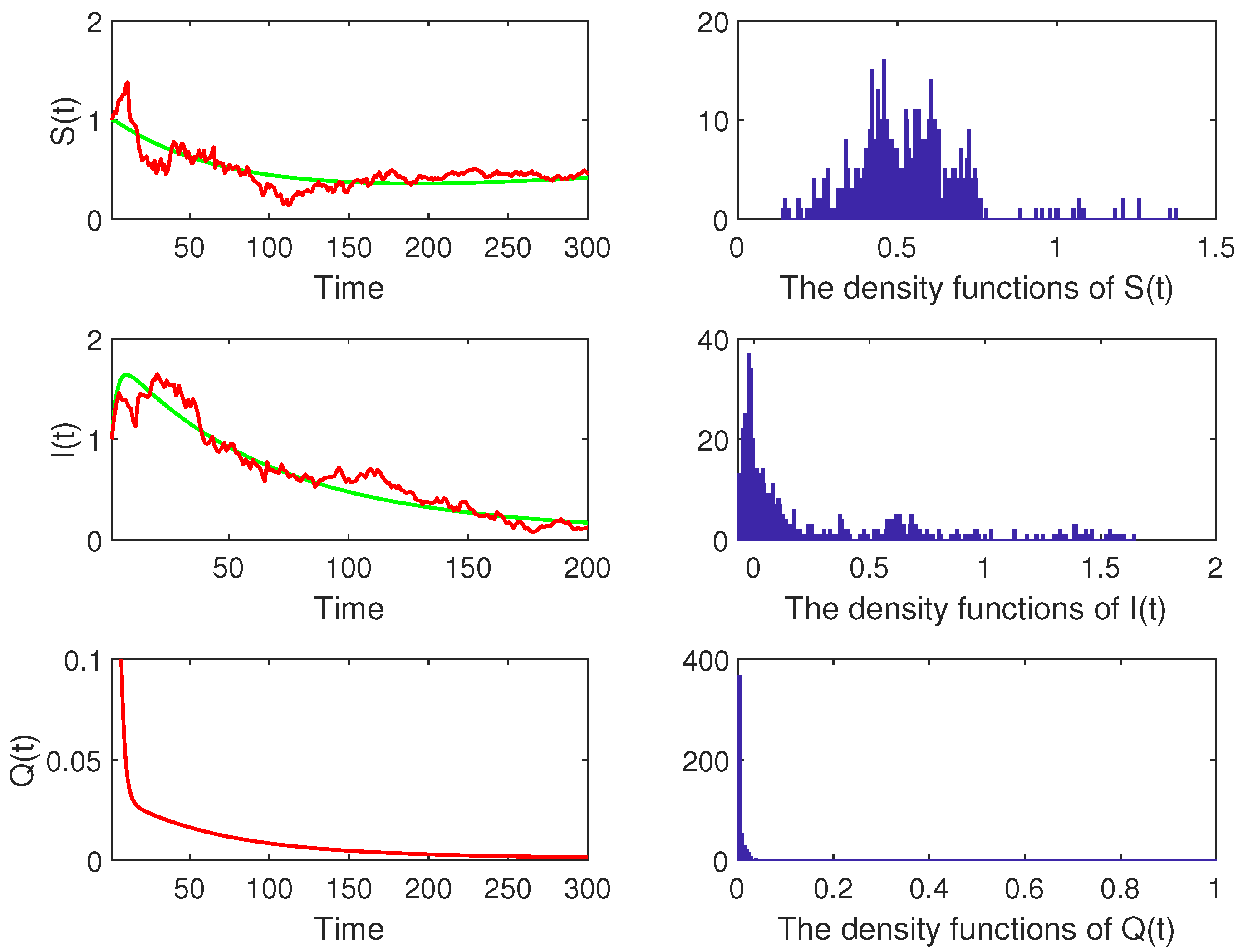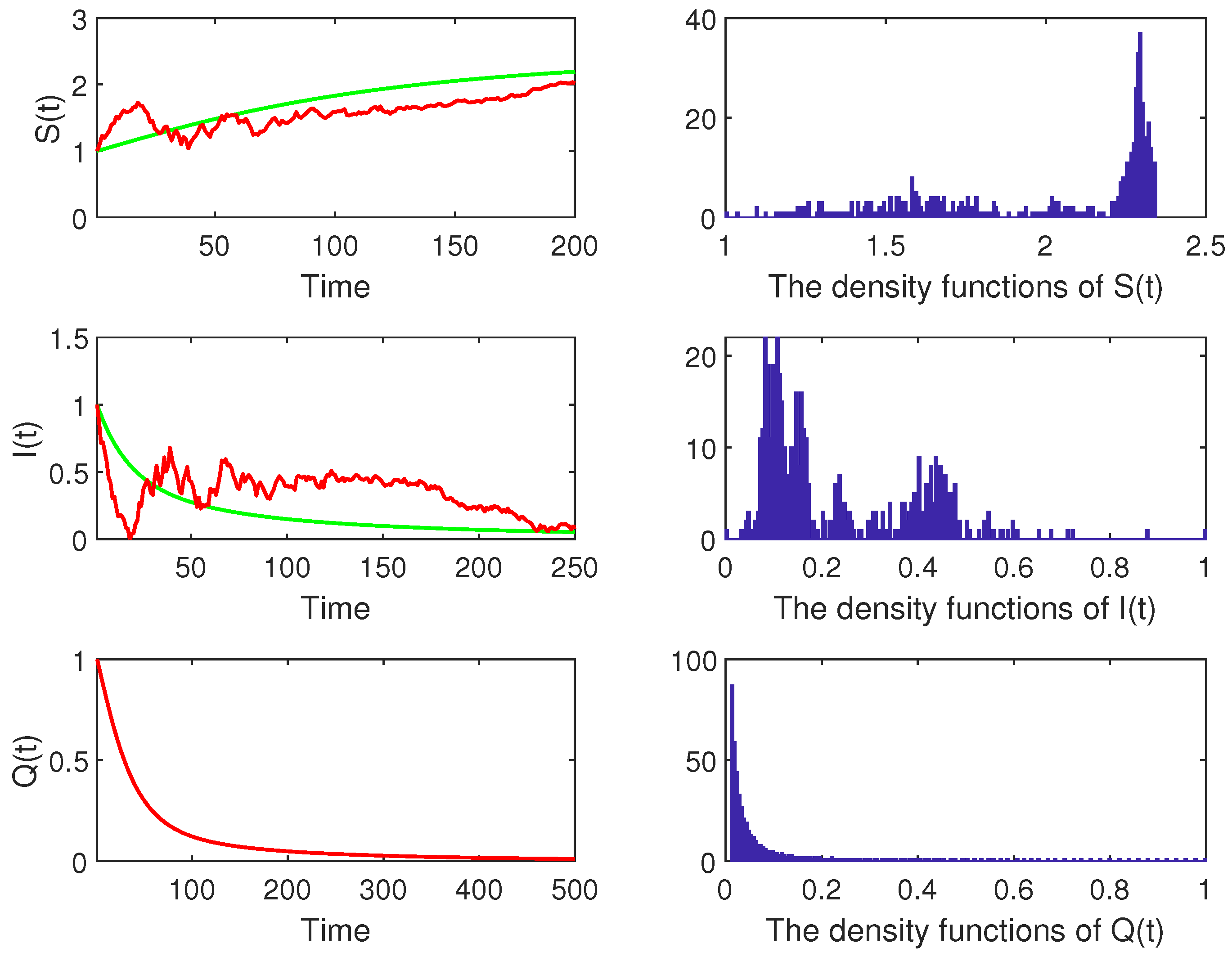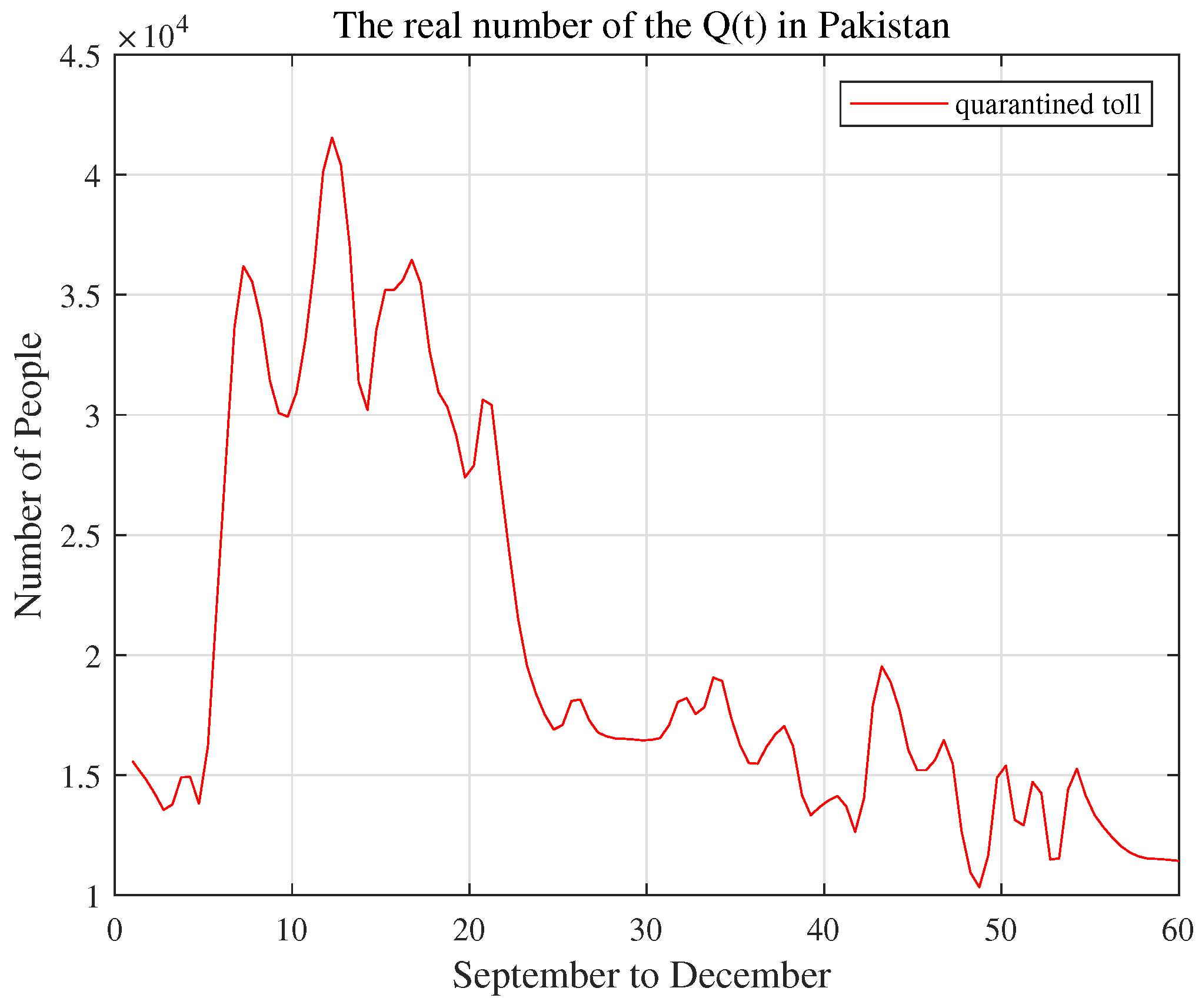Threshold Dynamics and the Density Function of the Stochastic Coronavirus Epidemic Model
Abstract
:1. Introduction
2. Preliminaries
3. Existence and Uniqueness of the Global Positive Solution
4. Ergodic Stationary Distribution of the Stochastic Coronavirus Epidemic Model
- (B.1) there is a positive number M such that ;
- (B.2) there exists a nonnegative function V such that is negative for any . Then,
5. Extinction of the Stochastic Coronavirus Epidemic Model
6. The Probability Density Function of the Stochastic Coronavirus Epidemic Model
7. Examples and Numerical Simulations
8. Discussion
Author Contributions
Funding
Institutional Review Board Statement
Informed Consent Statement
Data Availability Statement
Conflicts of Interest
References
- Lai, C.C.; Shih, T.P.; Ko, W.C.; Tang, H.J.; Hsueh, P.R. Severe acute respiratory syndrome coronavirus 2 (SARS-CoV-2) and corona virus disease-2019 (COVID-19): The epidemic and the challenges. Int. J. Antimicrob. Agents 2020, 53, 105924. [Google Scholar] [CrossRef] [PubMed]
- Wu, Z.; Mcgoogan, J.M. Characteristics of and important lessons from the coronavirus disease 2019 (COVID-19) outbreak in china: Summary of a report of 72 314 cases from the chinese center for disease control and prevention. JAMA 2020, 323, 1239–1242. [Google Scholar] [CrossRef] [PubMed]
- Mao, X. Stochastic Differential Equations and Applications; Horwood: Chichester, UK, 1997. [Google Scholar]
- Has’miniskii, R. Stochastic Stability of Differential Equations; Horwood: Chichester, UK, 1997. [Google Scholar]
- Mao, X.; Marion, G.; Renshaw, E. Environmental Brownian noise suppresses explosions in population dynamics. Stoch. Process. Appl. 2002, 97, 95–110. [Google Scholar] [CrossRef]
- Alzahrani, E.O.; Khan, M.A. Modeling the dynamics of hepatitis E with optimal control. Chaos Solit. Fract. 2018, 116, 287–301. [Google Scholar] [CrossRef]
- Wilder-Smith, A.; Freedman, D.O. Isolation, quarantine, social distancing and community containment: Pivotal role for old-style public health measures in the novel coronavirus (2019-nCoV) outbreak. J. Travel Med. 2020, 27, taaa020. [Google Scholar] [CrossRef] [PubMed]
- Han, B.; Zhou, B.; Jiang, D.; Hayat, T.; Alsaedi, A. Stationary solution, extinction and density function for a high-dimensional stochastic SEI epidemic model with general distributed delay. Appl. Math. Comput. 2021, 405, 126236. [Google Scholar] [CrossRef]
- Thomas, C.G. Introduction to Stochastic Differential Equations; Dekker: New York, NY, USA, 1988. [Google Scholar]
- Gao, M.M.; Jiang, D.; Hayat, T.; Alsaedi, A. Threshold behavior of a stochastic Lotka-Volterra food chain chemostat model with jumps. Phys. A 2019, 523, 191–203. [Google Scholar] [CrossRef]
- Siqueira, J.D.; Goes, L.R.; Alves, B.M.; da Silva, A.C.P.; de Carvalho, P.S.; Cicala, C.; Arthos, J.; Viola, J.P.; Soares, M.A. Distinguishing SARS-CoV-2 bonafide re-infection from pre-existing minor variant reactivation, Infection. Genet. Evol. 2021, 90, 104772. [Google Scholar] [CrossRef] [PubMed]
- Lipster, R. A strong law of large numbers for local martingales. Stochastics 1980, 3, 217–218. [Google Scholar]
- Griffin, B.D.; Chan, M.; Tailor, N.; Mendoza, E.J.; Leung, A.; Warner, B.M.; Duggan, A.T.; Moffat, E.; He, S.; Garnett, L.; et al. SARS-CoV-2 infection and transmission in the North American deer mouse. Nat. Commun. 2021, 12, 3612. [Google Scholar] [CrossRef]
- Khan, M.A.; Abdon, A. Modeling the dynamics of novel coronavirus (2019-nCoV) with fractional derivative. Alex. Eng. J. 2020, 59, 2379–2389. [Google Scholar] [CrossRef]
- Abdon, A. Modelling the spread of COVID-19 with new fractal-fractional operators: Can the lockdown save mankind before vaccination. Chaos Solitons Fractals 2020, 136, 109860. [Google Scholar]
- Zhou, B.; Zhang, X.; Jiang, D. Dynamics and density function analysis of a stochastic SVI epidemic model with half saturated incidence rate. Chaos Solitons Fractals 2020, 137, 109865. [Google Scholar] [CrossRef]
- Chen, Y.; Cheng, J.; Jiang, Y.; Liu, K. A time delay dynamic system with external source for the local outbreak of 2019-nCoV. Appl. Anal. 2020, 12, 1–12. [Google Scholar] [CrossRef]
- Din, A.; Khan, A.; Baleanu, D. Stationary distribution and extinction of stochastic coronavirus (COVID-19) epidemic model. Chaos Solitons Fractals 2020, 139, 110036. [Google Scholar] [CrossRef] [PubMed]
- Available online: http://covid.gov.pk/ (accessed on 10 January 2022).
- Herwaarden, O.A.; Grasman, J. Stochastic epidemics: Major outbreaks and the duration of the endemic period. J. Math. Biol. 1995, 33, 581–601. [Google Scholar] [CrossRef] [PubMed]
- Roozen, H. An asymptotic solution to a two dimensional exit problem arising in population dynamics. SIAM J. Appl. Math. 1989, 49, 1973. [Google Scholar] [CrossRef] [Green Version]
- Hethcote, H.W. Qualitative analyses of communicable disease models. Math. Biosci. 1976, 28, 335–356. [Google Scholar] [CrossRef]





| Parameter | Definitions |
|---|---|
| The susceptible class | |
| Infected people | |
| Carriers (dead corpse) | |
| Recovered persons | |
| Total number of deaths | |
| Rate of natural death recruitment rate into | |
| Probability of an class to join class | |
| Death rate induced by COVID-19 | |
| Recovery rate of class | |
| Force of infection of class | |
| Recovery rate of class | |
| Rate at which an class is recovered | |
| Rate at which treated persons become class |
| Parameter | Definitions |
|---|---|
| The susceptible class | |
| Infected people | |
| Quarantined people | |
| N | Total population |
| Capita constant fecundity rate | |
| Infection rate | |
| Infected natural mortality rate | |
| Quarantined natural mortality rate | |
| Disease-related mortality rate | |
| The constant rate of quarantining infected | |
| The quarantined rate from infected people | |
| Brownian motion | |
| The intensity of |
Publisher’s Note: MDPI stays neutral with regard to jurisdictional claims in published maps and institutional affiliations. |
© 2022 by the authors. Licensee MDPI, Basel, Switzerland. This article is an open access article distributed under the terms and conditions of the Creative Commons Attribution (CC BY) license (https://creativecommons.org/licenses/by/4.0/).
Share and Cite
Sun, J.; Gao, M.; Jiang, D. Threshold Dynamics and the Density Function of the Stochastic Coronavirus Epidemic Model. Fractal Fract. 2022, 6, 245. https://doi.org/10.3390/fractalfract6050245
Sun J, Gao M, Jiang D. Threshold Dynamics and the Density Function of the Stochastic Coronavirus Epidemic Model. Fractal and Fractional. 2022; 6(5):245. https://doi.org/10.3390/fractalfract6050245
Chicago/Turabian StyleSun, Jianguo, Miaomiao Gao, and Daqing Jiang. 2022. "Threshold Dynamics and the Density Function of the Stochastic Coronavirus Epidemic Model" Fractal and Fractional 6, no. 5: 245. https://doi.org/10.3390/fractalfract6050245
APA StyleSun, J., Gao, M., & Jiang, D. (2022). Threshold Dynamics and the Density Function of the Stochastic Coronavirus Epidemic Model. Fractal and Fractional, 6(5), 245. https://doi.org/10.3390/fractalfract6050245






